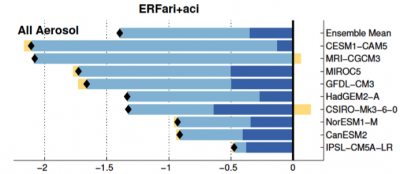Detailing Aerosol-Cloud-Radiation Interactions using Simple Diagnostics
The interaction of anthropogenic aerosols with radiation and clouds is the largest source of uncertainty in the radiative forcing of the climate during the industrial period. Understanding and quantifying aerosol-radiative interactions and aerosol-cloud interactions has long been hampered by different approaches used by different researchers. Here we show how the effective radiative forcing due to aerosol-radiation interactions (ERFari) and due to aerosol-cloud interactions (ERFaci) can be computed and partitioned among its various contributions using standard climate model output.
We apply two techniques borrowed from the cloud feedback literature to aerosol perturbation experiments performed in CMIP5. We find that the ensemble mean shortwave ERFari+aci of -1.40±0.56 Wm−2 comes roughly 25% from ERFari and 75% from ERFaci. ERFari is made up of -0.62±0.30 Wm−2 due to aerosol scattering opposed by +0.26±0.12 Wm−2 due to aerosol absorption, and is largest near emissions sources. The presence of clouds reduces the magnitude and inter-model spread of ERFari by 40-50%, making the change in clear-sky flux a biased proxy for aerosol direct effect. ERFaci, which is large both near and downwind of emission sources, is comprised of -0.99±0.54 Wm−2 from enhanced cloud scattering, with much smaller contributions from increased cloud amount and absorption. In models that allow aerosols to affect ice clouds, large increases in the optical depth of high clouds cause substantial radiative anomalies in both the longwave and shortwave parts of the spectrum. Inter-model spread in ERFaci is dominated by differences in how aerosols increase cloud scattering, but even if all models agreed on this effect, over a fifth of the spread in ERFaci would remain due solely to differences in total cloud amount.
We have shown that techniques borrowed from the cloud feedback literature provide a wealth of quantitative information on the various contributors to ERFari and ERFaci in models. Since these quantities can be computed systematically and efficiently across models using commonly available model output, this technique is an outstanding tool for understanding sources of inter-model differences in this key climate forcing, and may aid in comparing aerosol effects on climate between models and observations.
We thank Ulrike Burkhardt, Steve Ghan, Yi Ming, Rob Wood, and two anonymous reviewers for their useful comments on this work and Jin-Ho Yoon for providing CAM5 output. The work of M.D.Z. and K.E.T. is supported by the Regional and Global Climate Modeling Program of the Office of Science at the DOE and is performed under the auspices of the U.S. Department of Energy by Lawrence Livermore National Laboratory under contract DE-AC52-07NA27344. T.A. is supported by the Joint DECC/Defra Met Office Hadley Centre Climate Programme (GA01101). P.M.F. is a Royal Society Wolfson Merit Award holder and supported by the EPSRC IAGP project EP/I014721/1. We acknowledge the World Climate Research Programme's Working Group on Coupled Modelling, which is responsible for CMIP, and we thank the climate modeling groups (listed in the section 2 of this paper) for producing and making available their model output. For CMIP the U.S. Department of Energy's Program for Climate Model Diagnosis and Intercomparison provides coordinating support and led development of software infrastructure in partnership with the Global Organization for Earth System Science Portals.

